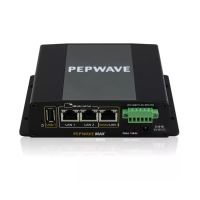USER MANUAL
Peplink Balance Series
http://www.peplink.com -118 / 261 - Copyright © 2015 Peplink
13.2 The Peplink Balance Behind a NAT Router
The Peplink Balance supports establishing SpeedFusion
TM
over WAN connections
which are behind a NAT (network address translation) router.
To enable a WAN connection behind a NAT router to accept VPN connections, you can
configure the NAT router in front of the WAN connection to inbound port-forward TCP
port 32015 to the Peplink Balance.
If one or more WAN connections on Unit A can accept VPN connections (by means of
port forwarding or not), while none of the WAN connections on the peer Unit B can do
so, you should enter all of Unit A’s public IP addresses or hostnames into Unit B’s
Remote IP Addresses / Host Names field. Leave the field in Unit A blank. With this
setting, a SpeedFusion
TM
connection can be set up and all WAN connections on both
sides will be utilized.
See the following diagram for an example of this setup in use:
One of the WANs connected to Balance A is non-NAT’d (212.1.1.1). The rest of the WANs
connected to Balance A and all WANs connected to Balance B are NAT’d. In this case,
the Peer IP Addresses / Host Names field for Balance B should be filled with all of
Balance A’s hostnames or public IP addresses (i.e., 212.1.1.1, 212.2.2.2, and 212.3.3.3),
and the field in Balance A can be left blank. The two NAT routers on WAN1 and WAN3
connected to Balance A should inbound port-forward TCP port 32015 to Balance A so
that all WANs will be utilized in establishing the VPN.

